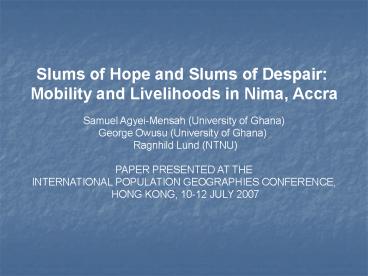Slums of Hope and Slums of Despair: - PowerPoint PPT Presentation
1 / 19
Title:
Slums of Hope and Slums of Despair:
Description:
... of poverty, which is one of the challenges of the Millennium ... Observations and interpretation of photos. Secondary information (census data) Surveys? ... – PowerPoint PPT presentation
Number of Views:474
Avg rating:3.0/5.0
Title: Slums of Hope and Slums of Despair:
1
Slums of Hope and Slums of Despair Mobility and
Livelihoods in Nima, Accra Samuel Agyei-Mensah
(University of Ghana) George Owusu (University of
Ghana) Ragnhild Lund (NTNU) PAPER PRESENTED AT
THE INTERNATIONAL POPULATION GEOGRAPHIES
CONFERENCE, HONG KONG, 10-12 JULY 2007
2
- OUTLINE
- INTRODUCTION
- LOCATION AND SOCIO- DEMOGRAPHIC
- CHARACTERISTICS
- ANALYTICAL APPROACH
- ASSUMPTIONS
- METHODOLOGY
- STORIES OF DESPAIR
- 7. STORIES OF HOPE
- 8. CONCLUSIONS
3
INTRODUCTION Urban slums are generally
classified as one of the worlds most
life-threatening environments. They are also the
most visible manifestation of the urbanization
of poverty, which is one of the challenges of the
Millennium Development Goals. It has been
estimated that 72 percent of the urban population
in Sub-Saharan Africa lives in slums. This
compares to 32 per cent for the whole world.
According to the Ghana Poverty Reduction Strategy
Report 2003 ,in 2001 about 4,993,000 people were
living in slums in Ghanaian cities. The slum
areas are very pronounced in major cities in
Ghana such as Accra and Kumasi.
4
While slums have generally been viewed in
negative terms, recent studies have given
testimony to the ingenuity of the people who live
in such places. Slums have also been viewed as
homogenous and static, and there is often a
failure to compare the subtle differences within
slums. The links between migration and
livelihoods have not been extensively examined,
and this study does this by focusing on Nima, the
major slum community in Accra, Ghana.
5
RESIDENTIAL MAP OF ACCRA SHOWING NIMA
6
Ethnic Composition of Nima, 2000
Source Ghana Population and Housing Census-Ghana
Statistical Service
7
Religious Affiliation of Population
Source Ghana Population and Housing Census
Ghana Statistical Service
8
AGE SEX DISTRIBUTION-NIMA
9
Population Growth and Density Characteristics of
Nima
10
ANALYTICAL APPROACH
Livelihoods frameworks imply identification and
analyses of i. shocks and vulnerabilities,
ii. assets, iii. structural mechanisms
and iv. outcomes.
11
ANALYTICAL APPROACH
Livelihood systems research has been used by
donors as guidelines for planning and
implementation and by researchers as analytical
frameworks. They have been criticised for being
static and instrumental and not incorporating
social change. Very few studies have applied
frameworks that integrate migration/peoples
mobility and livelihoods.
12
ANALYTICAL APPROACH
This paper makes use of the livelihoods framework
in a modified form. Major emphasis here is on
access to and control over assets and resources
and to identify where and how migration/mobility
is linked to livelihoods strategies and outcomes.
It is believed that such a perspective may
provide new insights into what constitutes urban
poverty in the postmodern era, and hence identify
what constitutes the new faces of poverty in
the process. An increasing growth of urban
slums in Ghana, it is believed, are intertwined
with structural reforms such as SAP, which is
believed to have increased urbanisation.
13
People in Nima pursue multiple livelihoods
strategies which are connected to
migration ?NIMA is a transitionary place for
rural-urban/intra urban migration ?People in
NIMA have close links with their home
places Migration takes place for a variety of
reasons Not all people in NIMA are poor NIMA
is a viable community, which thrives on external
contacts and contributions from migrants
(socially and economically)
ASSUMPTIONS
14
METHODOLOGY In-depth
interviews of key informants Individual
narratives/life histories from particularly
successful as well as vulnerable groups
(entrepreneurs, women, youth/children, elderly
and disabled) Group discussions (traditional
leaders, authorities, CBOs) Observations and
interpretation of photos Secondary information
(census data) Surveys?
15
STORIES OF DESPAIR
16
STORIES OF DESPAIR
17
Stories of Despair
18
STORIES OF HOPE
19
CONCLUSIONS
- Great variations and complexity in livelihoods
- High unemployment, poor environmental sanitation
- A place with active presence of entrepreneurs
engaged in national and international trade - Nima reminds policy makers that while slums
constitute a crucial ingredient in the recent
rapid urbanization of Ghana, they reflect hope
and efforts to escape poverty by many urban
Ghanaians.































